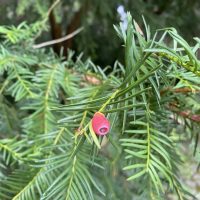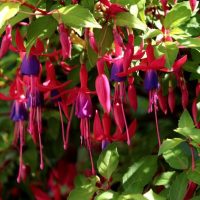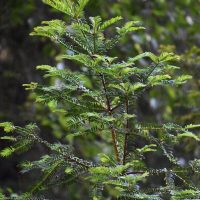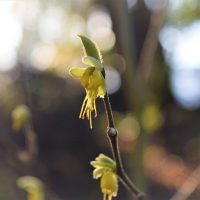Plant Profile: Taxus brevifolia

Scientific Name: Taxus brevifolia
Common Name: Pacific yew, western yew
Family: Taxaceae
Native Range: Western coast of the United States, from southern Alaska to northern California; western Rocky Mountains, from northern British Columbia to Idaho and Montana
Location in the Arboretum: South end of the Arboretum above Azalea Way (Grid 17-1E)
The Pacific yew, Taxus brevifolia, is a native tree or large shrub that is often overlooked below the overstory of large iconic Pacific Northwest trees such as Western redcedars, Douglas firs, and Western hemlocks.
August Plant Profile: Camellia sasanqua
Scientific Name: Camellia sasanqua
Common Name: sasanqua camellia; the Japanese name for all camellias is tsubaki,“tree with shining leaves,” while the Japanese name for Camellia sasanqua is sazanka, “plum-flowered tea.”
Family: Theaceae
Conservation Status: Least Concern
Native Range: Lowland forests of southern Japan
Culture/Habit: Organically rich, evenly moist, well-drained soils in shade to sun. Small trees to 16 feet tall or vining shrubs growing wider than tall, often depending on sun exposure.
July Plant Profile: European Beech
Scientific name: Fagus sylvatica
Common Name: Common beech, European beech
Family: Fagaceae (Oak family)
Conservation Status: Least Concern
Locations in the Washington Park Arboretum: Oak Collection area, directly east from the Graham Visitor Center
Fagus sylvatica, 3 specimens 595-44-A &B & 907-50-A: grids 42-1E, 43-1E
F.sylvatica ‘Aspleniifolia’ 1142-49-A: grid 41-1E
F.sylvatica ‘Dawyck’ 490-57-A: grid 40-1E
F.sylvatica ‘Riversii’ 682-67-A: grid 44-B
F.sylvatica ‘Rohanii’ 382-50-A: grid 42-1E
F.sylvatica ‘Spaethiana’ 654-54-A: grid 42-1E
F.sylvatica f.
March 2024 Plant Profile: Japanese Ornamental Cherry Tree Acquisitions
Scientific name: Prunus species
Various species:
P. Sato-zakura Group: Cultivars: ‘Shirotae’, ‘Shoetsu’, ‘Ukon’ ‘Chosho-Hizakura’, Sekiyama’
‘Ohochin’ ‘Oeshokun’
P. serrulata: Cultivars: ‘Asagi’ ‘Iohiyo’, ‘Shirofugen’, ‘Tai-Haku’, ‘Taoyome’ ‘Wase-Miyako’ ‘Horinji’
P. subhirtella: Cultivars: ‘Eureka Weeping’ ‘Pendula’ ‘Rosea’ ‘Stellata’ ‘Higan Weeping’ ‘Whitcomb’
P. sargentii: Cultivar: ‘Pink Flair’
Prunus x yedoensis: Cultivar: ‘Akebono’, ‘Shidare-yoshino’, ‘Somei-Yoshino’
P. x juddii
Common name: Japanese Ornamental Cherry
Family: Rosaceae
Native Range: Japan
In the Arboretum: Along Azalea Way
Issues: brown rot, cherry bark tortrix larvae, crown gall, root rot, low tolerance of compacted or wet soils
During spring’s first blossoms, I brag to anyone who will listen that the Japanese ornamental cherries at the Washington Park Arboretum are the most amazing display in the city and that they MUST go for a walk along Azalea Way to view this splendor.
Read moreFebruary Plant Profile: Wheel Tree

Scientific name: Trochodendron aralioides
Synonyms: Trochodendron longifolium
Common name: Wheel tree, parasol tree, birdlime tree, yamaguruma, nagaba-no-yamguruma, kun lan shu, ka-tang-lai
Family: Trochodendraceae
Native Range: Japan (south of Yamagata), Kyushu, Shikoku, Ryuku Islands, Taiwan
Height and Spread: May grow from 60-75 tall feet in the wild with trunks as large as 16 feet in diameter, typically 20-25 feet tall by 10-15 feet wide in cultivation.
October Plant Profile: Tree of Heaven
Scientific name: Ailanthus altissima
Common name: Tree of Heaven, Stinking Sumac, Paradise Tree
Family: Simaroubaceae
Native Range: Taiwan and China, hardy to USDA Zone 4
Habit: Grows between 60-90 feet tall and can grow to around 25 feet in a single year. The bark is smooth and tan to gray in early growth. With age, bark will become rugged with heart-shaped leaf scars.
August 2023 Plant Profile: Cornelian Cherry

Scientific name: Cornus mas
Common name: Cornelian cherry, European cornel, Cornelian cherry dogwood
Family: Cornaceae (Dogwoods)
Native range: Southern and central Europe to western Asia
Location: At the Center for Urban Horticulture, there is a grove located in the northern lawn area along the central drive and the trees’ accession numbers are 87-90. At the Arboretum, there are three specimens under the accession number of 704-38 (grid 33-B) from the original planting of the Woodland Garden in 1938.
July 2023 Plant Profile: Hummingbird Fuchsia

Hardy Fuchsia love sun and do fine in part shade. Once established they tend to be drought hardy plants – I have one in my yard that I never water in summer and it has thrived over the past 15 years. They are the hardiest species of the Fuchsia genus and are rated for USDA Zones 6 & 7.
Read moreJune 2023 Plant Profile: Japanese Nutmeg Tree

In Japan, the seeds of the nutmeg yew are desirable to be roasted and eaten or used to produce a cooking oil with a subtle nutty flavor highly prized in some circles for tempura. The ‘nuts’ are rich in vitamin E as well as sciadonic acid, known to reduce cholesterol.
Read moreApril 2023 Plant Profile: Western Leatherwood

As Spring arrives, we here in the Pacific Northwest are gifted the opportunity to observe a wide variety of plant species we may not have noticed before. This month, we are focusing in on a beautiful, rare, San Francisco Bay-area endemic shrub. Dirca occidentalis can be found in the Washington Park Arboretum, but wait… what is it doing here?
Read more